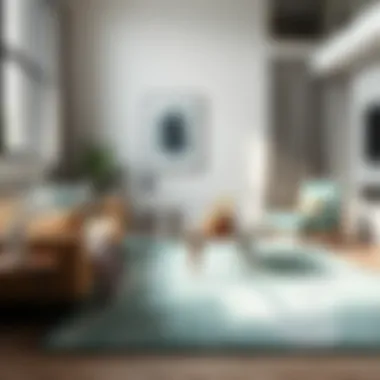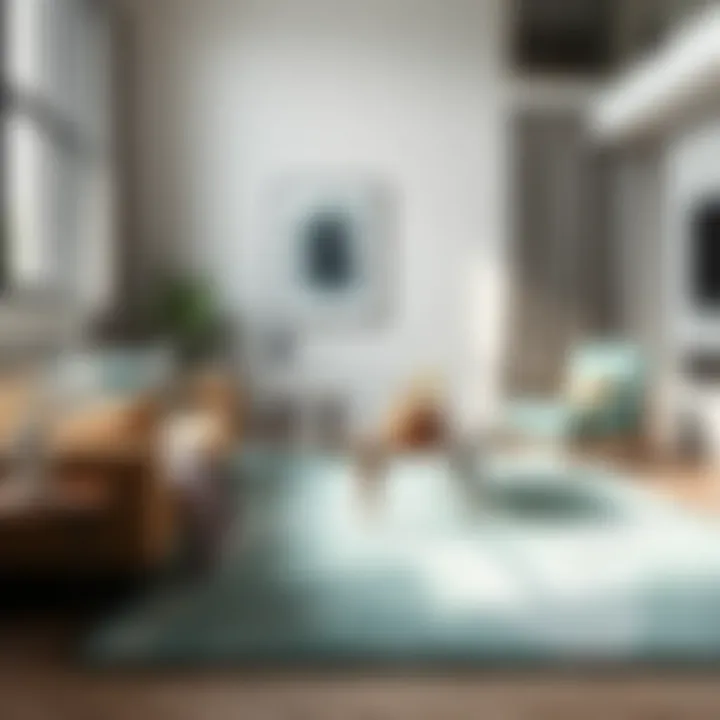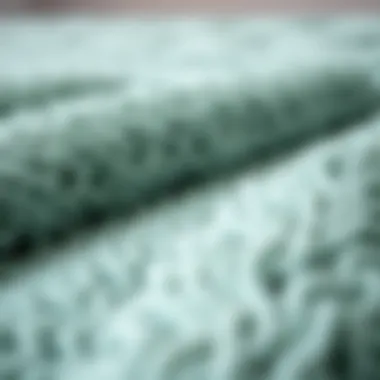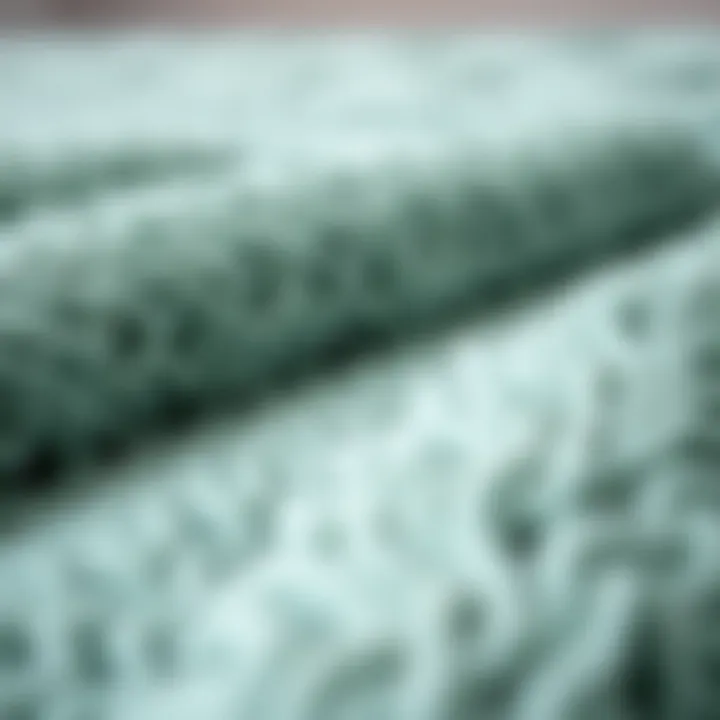Mint Rugs: Transforming Modern Interior Spaces


Intro
Mint rugs are making a significant impact in contemporary interior design, bringing a breath of fresh air and an elegant touch to spaces. Their soothing color invites tranquility, while the diverse textures and patterns available cater to various tastes. As homeowners, designers, and DIY enthusiasts seek to create environments that reflect personal style, mint rugs offer a versatile option, merging aesthetics with functionality. Understanding the essence of these rugs involves exploring current design trends, practical buying guides, and maintenance tips that expand their appeal in today’s homes.
By incorporating mint rugs thoughtfully into different areas, one can achieve a cohesive look that enhances overall interior harmony. Whether in a vibrant living room or a serene bedroom, the right mint rug can serve as a focal point or a subtle complement to existing decor. This exploration is more than just about aesthetics; it's a dive into how these rugs contribute to feelings of comfort and peace in a home setting.
In this article, we will dissect the role of mint rugs within various design trends, offer guidance on purchasing decisions, and discuss the maintenance needed to keep them looking their best. From understanding how to incorporate the latest trends into your space to assessing quality and value, readers will discover all the tools necessary to make informed choices in the world of mint rugs.
Prelims to Mint Rugs
When it comes to interior design, many homeowners and designers find themselves on the lookout for unique elements that can enliven a space. Mint rugs represent a distinctive choice that can infuse a breath of fresh air into modern homes. Their subtle yet striking color offers not just a decorative aspect but also holds significance in psychological and emotional undertones. In this section, we will explore the particulars that define mint rugs, including their unique attributes and the history that has shaped their place in contemporary interiors.
Defining Mint Rugs
Mint rugs can be described as textiles that boast a soothing greenish-blue hue reminiscent of fresh mint leaves. This particular shade is versatile enough to suit various design aesthetics—from sleek modern spaces to more rustic homes. The vibrancy of mint can drastically influence the atmosphere of a room, drawing the eye and inviting a sense of tranquility. Unlike darker colors, which can sometimes feel heavy, mint rugs provide a lightness that can enhance the perception of space within a room.
Most mint rugs are crafted from a variety of materials—ranging from natural fibers like wool and cotton to synthetics like polyester. This variety caters to different consumer needs, spanning aesthetic preferences, budget considerations, and practical functionality.
Historical Context
The journey of mint rugs is rich and steeped in cultural significance. Historically, the color mint has been associated with freshness and serenity in numerous cultures. For instance, in ancient civilizations, mint was esteemed not solely for its aroma but also for its calming properties. As such, spaces adorned with mint tones—whether through textiles, wall paints, or decor—were often deemed peaceful retreats.
In design history, the use of green hues can be traced back to the Arts and Crafts movement in the late 19th and early 20th centuries, where artisans emphasized nature's inspiration in their work. Over the decades, mint as a color has ebbed and flowed in popularity, becoming a staple in more modern interior trends as designers re-embrace the emotional and visual benefits it can offer. Today, mint rugs find themselves in a unique position to merge traditional craftsmanship with contemporary style, providing an excellent platform for designers and homeowners alike to express their individuality.
The growing interest in sustainability has also guided the rise of mint rugs, with natural fibers gaining traction among eco-conscious consumers. As people explore their spaces, they often seek elements that not only enhance beauty but also align with personal values. In doing so, mint rugs have crafted their own niche, catching the eye of enthusiasts who value both aesthetic pleasure and mindful consumption.
With a foundation laid that defines and contextualizes mint rugs, the next sections will delve deeper into why they are worth considering for any interior space.
Why Choose a Mint Rug?
Choosing a mint rug for your space is no small potatoes. This decision goes beyond simple preference; it envelopes an entire atmosphere, influencing both vibe and visual narrative. Mint rugs bring a breath of fresh air into contemporary interiors. Their serene hue often aligns perfectly with the modern quest for tranquility amid chaos, making them a well-positioned choice for various settings. Let's dive into the reasons that make mint rugs a standout component of any decor scheme.
Aesthetic Appeal
Mint rugs are more than mere floor coverings; they are statement pieces that can redefine an entire room. The subtle yet invigorating shade of mint invites a certain calmness while seamlessly fitting into multiple design aesthetics—be it bohemian, minimalist, or even farmhouse rustic.
- Versatility: Mint is a unique color that pairs beautifully with a variety of palettes. It's neither overpowering nor bland. It contrasts well with warm colors like coral or gold, adding a layer of depth to your space. Pair it with white for an airy look or with deep blues for a sophisticated vibe.
- Texture and Quality: The appeal doesn’t just stop on the surface. The rug's texture can evoke feelings of comfort and coziness, especially when choosing natural fibers. Such quality transforms any room into a potentially inviting space where one would love to sit back and relax.
- Trendy Timelessness: While mint color pings on trend charts frequently, it has an underlying timelessness. It’s a hue classic enough that you needn't worry about it falling out of fashion anytime soon. Essentially, by opting for a mint rug, you are making a stylish investment.
Color Psychology
Colors have the power to tweak our emotions and behaviors in subtle but profound ways. Mint holds a special spot in the color psychology hierarchy. Consider how this unique color influences your surroundings and psyche.
- Calmness: Mint is often associated with tranquility and freshness. It brings to mind cool breezes and gentle spring mornings. This psychological aspect makes it a prime candidate for rooms meant for relaxation, like the bedroom or reading nook.
- Creativity and Innovation: Experts suggest that colors can stimulate creativity. Being surrounded by mint could foster a more innovative mindset. If you're designing an office or creative space, integrating a mint rug may help spur new ideas and encourage out-of-the-box thinking.
- Versatility in Mood Setting: Depending on how mint is employed in your decor, the mood can shift easily—from cool and serene to lively and energetic. A darker shade of mint might create a more inviting, warm atmosphere, while a pastel take could enhance lightness and openness in your space.
"Incorporating a mint rug might just be the missing puzzle piece in creating that perfect ambiance you’ve been searching for."
Ultimately, deciding to introduce a mint rug into your home isn't just about aesthetics; it's about fostering an entire mood and energy within your environment. This mindful choice goes a long way in creating the sanctuary you've always wanted.
Various resources to explore further:
Taken together, the aesthetic and psychological benefits of mint rugs make a compelling case for their inclusion in modern interiors.
Materials Used in Mint Rugs
In the vibrant world of interior design, the materials used in mint rugs play a crucial role. They can influence not just the aesthetic appeal but also durability, maintenance needs, and overall comfort. With mint rugs increasingly becoming a favorite choice among homeowners and designers alike, understanding the underlying materials can help one make informed decisions when selecting the perfect rug for their space.


Natural vs. Synthetic Fibers
When considering the materials for mint rugs, the age-old debate between natural and synthetic fibers arises. Natural fibers like wool, cotton, and jute offer several advantages that are often hard to beat. Wool, for example, is celebrated for its resilience and warmth. A wool mint rug can cushion underfoot and can easily withstand foot traffic that might otherwise wear a synthetic alternative thin. Also, because of its inherent structure, wool can repel dirt and stains, making it a solid choice for busy areas of the home.
On the other hand, synthetic fibers such as polyester and nylon have gained considerable traction in the rug market, thanks to their cost-effectiveness and ease of maintenance. A synthetic mint rug can often mimic the look of natural fibers without the hefty price tag. They are also less prone to fading, which can be a significant consideration for spaces that receive abundant sunlight. However, it’s essential to note that while synthetic versions offer durability, they may lack the genuine feel and elegance that natural materials exude. Ultimately, choosing between natural and synthetic fibers comes down to personal preferences and practical needs. Homeowners should weigh the pros and cons of each material while considering their lifestyle and design ethos.
Common Material Choices
Mint rugs are typically made from a diverse range of materials, each with unique characteristics that cater to different tastes and requirements:
- Wool: Known for its luxurious texture, wool serves as a timeless choice for those seeking comfort without compromising on style. Its natural insulating properties keep spaces cozy during colder months.
- Cotton: Lightweight and easy to wash, a cotton mint rug can add a breezy feel to a room. It's an excellent option for children's areas, as spills and messes can be tackled with relative ease.
- Jute: For an earthy and more rustic vibe, jute is appealing. It’s biodegradable and sustainable, aligning well with eco-conscious consumers.
- Polyester: Highly versatile, polyester is often blended with other fibers to create vibrant, colorful rugs that resist fading, making them perfect for lively spaces.
- Nylon: Known for its durability, nylon can withstand heavy foot traffic. It’s often treated to be stain-resistant, making it suitable for busy households.
In choosing a mint rug, consider not only how it looks but how its materials will perform in your day-to-day life. Assessing your lifestyle can guide you toward the most fitting option.
The choice of materials plays a pivotal role not only in the rug's appearance but also its functionality. This knowledge enables designers and homeowners to select rugs that not only beautify their spaces but also fulfill their practical needs. By understanding the nuances of natural versus synthetic fibers and the characteristics of common material choices, one can curate a space where mint rugs contribute to elegance and comfort.
Manufacturing Processes
Understanding the manufacturing processes of mint rugs is essential when exploring their role in contemporary interiors. These processes directly impact the quality, aesthetics, and sustainability of the rugs we see in various spaces today. The journey of a mint rug—from raw materials to the finished product—offers insights into craftsmanship, innovation, and design philosophy that can enhance a designer’s or homeowner’s decision-making process.
Traditional Handwoven Techniques
Handwoven techniques fundamentally articulate the soul of mint rugs. Craftsmanship here is not merely about producing a decorative item; it embodies a family of artisans who have honed their skills over generations. Compared to machine-made rugs, handwoven variants provide an authentic character and feel that often resonate with a story or tradition.
- Time-Intensive Process: Each rug being handwoven takes substantial time. This craftsmanship means that every piece can be seen as a work of art, making them often unique. The time and effort invested can be a point of appreciation for buyers who value artistry over mass production.
- Use of Natural Fibers: Traditional methods often favor natural materials like wool or cotton, which tend to have better durability and comfort. Using organic fibers can enhance the tactile experience and contribute to a room's ambiance positively.
- Cultural Preservation: Many civilizations have specific designs tied to their heritage. Each pattern woven carries meaning, making the piece not just furniture but a conversation starter about culture when placed in a modern interior.
However, this technique does come with challenges. The cost can be higher than machine-made alternatives. Additionally, the variety may be limited as artisans focus on specific styles and methods. Still, for those in search of authenticity and craftsmanship, traditional handwoven mint rugs can elevate any space exceptionally.
Modern Machine-made Rugs
On the flip side, modern machine-made rugs accommodate different needs and preferences in contemporary design. They push the boundaries of what is possible in terms of colors, patterns, and pricing. There are specific attributes that make them appealing to homeowners and designers alike.
- Cost-Effective Production: Machine manufacturing allows for creating rugs at scale, drastically reducing costs. This is useful for those working on a tight budget without compromising too much on style.
- Variety and Versatility: A huge range of design choices is at the disposal of consumers. From geometric patterns to abstract designs, machine-made mint rugs can cater to various tastes, ensuring that everyone can find something that reflects their style.
- Quick Availability: Unlike handwoven rugs that can take months to finish, machine-produced options offer quicker turnaround times. This is particularly relevant when a space needs instant refreshment or when preparing for events.
However, concerns about the longevity and authenticity of machine-made rug materials exist. The fibers used may not always match the quality of natural materials found in handwoven rugs. Many consumers opt for these for the immediate aesthetic but may find them lacking in warmth and character.
"Choosing between traditional and machine-made processes depends on how much value you place on artistry, function, and your individual style preferences."
In wrapping up this discussion on manufacturing processes, it balances the artistry of handcrafted techniques with the efficiency and accessibility of machine production. Homeowners must assess their priorities—be it authenticity, budget, or sheer design variety—when selecting the perfect mint rug for their space. Each method carries its significance in shaping not only the product but also the overall aesthetic and functional characteristics of contemporary interiors.
Styles and Patterns of Mint Rugs
When contemplating the impact of decor on interiors, the styles and patterns of mint rugs cannot be overlooked. They serve not just as functional items, but as central pieces that capture attention and define the space. Mint rugs come in a myriad of styles—from geometric to floral to abstract—each offering unique advantages and considerations for both aesthetic and practical applications.
Geometric Designs
Geometric designs in mint rugs are not just a trend; they are a timeless choice that speaks to both order and transformation. These patterns can range from sharp lines and angles to softer curves, providing a clean and modern touch to any room. When paired with the right furnishings, geometric mint rugs can enhance spatial perception, making a room feel larger and more open.
"In the world of design, it's often the simplest shapes that hold the key to sophistication."
For homeowners looking to create a contemporary environment, these designs offer several benefits:
- Versatility: They anchor a room without overpowering it, allowing other elements to shine.
- Mood Elevation: The structured nature of geometric designs can provide a sense of tranquility, perfect for a zen-like atmosphere in a bedroom or a creative flair in a home office.
- Durability and Style: These rugs often disguise wear and tear better than more intricate patterns, making them practical as well as stylish.
Floral Motifs
Floral motifs lend a sense of organic elegance to mint rugs, bringing in nature’s vibrant colors and forms. This style can infuse spaces with warmth and personality. Unlike the cold precision of geometric designs, floral patterns evoke a sense of liveliness and softness that can transform any area into a cozy retreat.
When considering floral mint rugs, keep in mind:


- Connection to Nature: They can instantly connect indoor spaces to the beauty of the outdoors.
- Seasonal Adaptability: Depending on the motifs selected, these rugs can be suitable for various seasons, allowing for creative changes in decor.
- Diverse Interpretations: Florals can be either bold and colorful or soft and subtle, making it easier to match them to existing decor.
Abstract Patterns
Abstract patterns in mint rugs embrace randomness and artistic freedom, offering a canvas for creativity in design. Unlike more predictable styles, these patterns can serve as conversation starters, drawing attention and inviting speculation about their meanings and origins.
Key aspects to consider with abstract rugs include:
- Uniqueness: Each piece is often one-of-a-kind, making it a distinctive addition to any interior.
- Personal Expression: The chaotic nature of abstract art allows for individual interpretations, making the room feel more personal and tailored to one’s identity.
- Dynamic Energy: They introduce an element of energy and movement into spaces that might otherwise feel static.
Incorporating Mint Rugs in Interior Design
The integration of mint rugs into interior design is not just about adding color; it’s about creating an atmosphere that speaks to personal style while enhancing the overall aesthetic of a space. Mint rugs, with their refreshing hue, manage to strike a balance between soothing and vibrant, making them ideal for various environments. They can serve as a focal point in a minimalist room or harmonize with other elements in a busier decor. The selection of a suitable mint rug goes beyond mere color choice; it also involves an understanding of texture, pattern, and placement.
Living Room Applications
In the living room, mint rugs can redefine the comfort zone. They can brighten up an otherwise dull space, offering a pop of color that can easily complement both neutral and richer tones around the room. Imagine a light mint green rug beneath a coffee table surrounded by cream-colored sofas—it brings a sense of serenity and elegance, doesn’t it?
- Centerpiece Focus: A larger mint rug can serve as the heart of the living area, bringing unity to sectional arrangements.
- Layering Textures: Combine a plush mint rug with textured throw pillows and blankets for a cozy, inviting vibe.
- Contrast Play: Pairing with darker furniture or accent walls can create a dramatic yet appealing contrast, making the mint shade stand out brilliantly.
Incorporating a mint rug in the living room enhances spatial perception, indicating vibrancy and warmth while maintaining an airy feel.
Bedroom Enhancements
When it comes to the bedroom, mint rugs can transform a simple space into a serene retreat. The calming nature of mint makes it an optimal choice for spaces aimed at relaxation. From the bed frame to curtains, the rug can tie all elements together harmoniously. Here are a few ideas for effective incorporation:
- Bedside Comfort: A soft, plush mint rug peeking out from under the bed can provide a gentle landing spot for feet first thing in the morning.
- Soft Color Palette: Use the rug as a foundation to build a soft, pastel color palette, combining it with light pinks or grays for a tranquil atmosphere.
- Layering Effects: In smaller spaces, a layer of a mint rug over a neutral one can add depth and dimensions without overcrowding the design.
Office Spaces
Mint rugs in home office settings can foster creativity while maintaining professionalism. The refreshing tone can invigorate a workspace and enhance productivity. Here are some important elements to consider:
- Inspiration through Color: A mint rug can add a fresh touch to an otherwise sterile environment. It motivates and encourages positivity, essential for brainstorms or work sessions.
- Defining Zones: Utilizing a mint rug helps visually define the workspace, especially in open floor plans. It separates distinct areas for work versus relaxation.
- Ergonomics: Beyond aesthetics, a rug can provide comfort during long hours spent at a desk, reducing strain from hard flooring.
Practical Considerations
When embracing the allure of mint rugs in interior designs, it’s not just about their aesthetic appeal but also the practical considerations that come into play. Selecting the right rug involves a great deal of thought about how they function in our daily lives. For homeowners and designers alike, understanding maintenance, care, and durability factors becomes crucial to ensure that the investment made is truly worthwhile.
Maintenance and Care
Mint rugs, with their refreshing hue, can brighten up any space, but they also require a bit of TLC to maintain their charm. Regular upkeep can help prevent dirt buildup and preserve colors. Here are some tips for caring for your mint rug:
- Vacuum Regularly: Sweeping your rug every week keeps it free from dust and debris.
- Spot Clean Immediately: Should a spill happen, tackle it right away with a gentle detergent.
- Rotate Periodically: Rotating the rug every few months helps to prevent uneven wear and keeps colors looking vibrant.
- Professional Cleaning: Depending on the material, consider having it professionally cleaned every couple of years to handle deep-seated stains or accumulated dirt.
Our guide on rug maintenance emphasizes that taking these small steps can significantly extend the life of a mint rug, maintaining its pristine appearance for years to come.
Durability Factors
Durability is essential when choosing a rug, especially one as visibly striking as a mint rug. The longevity of your rug depends largely on its material and how it is used within a space. These rugs can face various challenges, and understanding these challenges can assist in making an informed choice:
- Material Quality: Natural fibers like wool tend to be more durable than synthetic counterparts, withstanding the test of time and heavy foot traffic.
- Backing Type: A strong backing can influence how well the rug holds up over years of use. Choosing one with a robust foundation will offer better wear resistance.
- Placement: Strategic placement matters a lot. Putting a mint rug in low-traffic areas, like bedrooms, can help it last longer than if placed in a bustling corridor.
Ultimately, recognizing these durability factors guides you in selecting not just a decorative piece, but one that stands resilient against daily wear and tear, allowing the beauty of mint to contribute to your space long-term.
"The right care and understanding of your mint rug can transform it from just a home accessory into a lasting part of your interior story."
By weaving together these practical considerations, the conversation about mint rugs deepens, drawing connections between beauty and practicality in design.


Potential Challenges of Mint Rugs
Mint rugs can undoubtedly transform spaces, but like any design element, they come with their set of challenges that homeowners and designers must consider. Understanding these challenges is crucial, not only for making informed purchasing decisions but also for ensuring the longevity and aesthetics of the rug in various settings. This section will focus on two significant potential challenges: color fading and compatibility issues with existing decor.
Color Fading
Color fading is one of the most pressing concerns for a mint rug, particularly in high-traffic areas or when exposed to sunlight for prolonged periods. This issue can significantly alter the intended look of your design. While mint rugs are cherished for their soothing shades and versatile appeal, they are not impervious to the elements.
- Sunlight Exposure: Direct sunlight can cause vibrant colors to lose their luster, turning vivid mint hues into lackluster pastels. If you position a rug near large windows, it may be wise to invest in UV-blocking shades to preserve its color.
- Cleaning Products: The cleaning solutions you might use can also affect the motley shades of mint rugs. Some detergents contain bleach or harsh chemicals, promoting fading. It’s advisable to opt for gentle, pH-neutral cleaners and to conduct spot tests before applying them to the entire rug.
Tip: Regular vacuuming and professional cleaning can help maintain the integrity of the rug’s color. Best practice also involves rotating the rug periodically to ensure even wear.
Compatibility Issues with Other Decor
Mint rugs, although versatile, present compatibility hurdles with certain color schemes and patterns. This challenge often stumps homeowners who wish to incorporate them but struggle to harmonize different aesthetic elements.
- Color Coordination: Mint can easily clash with bold colors or dark shades, reducing the overall visual appeal. For instance, pairing a mint rug with deep burgundy or navy without complementary features can create disarray in a room’s design.
- Pattern Mixing: Additionally, if the rug's geometric or abstract patterns are too busy, they might compete with other patterned elements within the space. Designers need to consider scale and proportion when combining patterns to avoid what may come off as a chaotic environment.
- Thematic Cohesion: Lastly, ensuring that a mint rug fits within the overall theme of the room is essential. A modern mint rug can feel out of place in a rustic or traditional setting unless carefully matched with appropriate décor items.
Intriguingly, homeowners can mitigate these compatibility issues by focusing on a cohesive color palette that allows mint to shine, rather than dominate. Some creative ways to achieve harmony include:
- Using mint accessories or accent pillows to tie the rug in with other decor.
- Selecting wall art that incorporates mint tones, further harmonizing the entire space.
- Keeping larger patterns minimalistic to allow the rug's unique character to stand out without overwhelming the room.
Understanding these potential challenges equips homeowners and designers alike with the knowledge necessary for cultivating a balanced and visually pleasing environment. Mint rugs have the ability to invigorate spaces, and with careful consideration of these challenges, they can thrive beautifully in contemporary interiors.
The Future of Mint Rugs in Design
The future of mint rugs in design holds both promise and challenge, as homeowners and designers alike continue to seek unique solutions that reflect contemporary aesthetics while addressing modern needs. Mint rugs stand out not just as decorative elements but also as cultural symbols that can bring harmony and refresh vibrant energy into living spaces.
This section delves into key elements shaping the future of these rugs – emerging trends that define the marketplace, alongside sustainability aspects that increasingly influence consumer behavior. More than just a fashion statement, mint rugs now represent thoughtful choices in both style and ethical sourcing.
Emerging Trends
Mint rugs are increasingly blending traditional craftsmanship with modern design philosophies. As styles evolve, the following trends have started to emerge:
- Mixed Materials: More designers are experimenting with combinations of materials. Innovations in weaving techniques have led to the creation of rugs that incorporate pops of color alongside mint, such as pastel pinks or bold navy.
- Artisan Collaborations: Collaborations with local artisans are on the rise. Consumers are looking for handcrafted rugs, which not only offer uniqueness but also tell a story. This gives mint rugs a layer of authenticity that mass-produced alternatives lack.
- Customizable Designs: In an age where personalization matters, consumers want the ability to customize designs to match their unique sense of style. Paint strokes of mint on geometric patterns or opt for abstract art influences can appeal to an array of tastes.
- Tech-Integrated Rugs: Interestingly, we see rugs that integrate smart technology. Think about a mint rug with embedded heating systems for cold floors or even LED designs that can shift colors based on mood or time of day.
Such trends reflect a shift towards integrating aesthetics with practicality and personal expression in contemporary design.
Sustainability Aspects
As society grows more conscious of environmental impacts, sustainability stands at the forefront of design decisions. For mint rugs, this involves a variety of dimensions:
- Eco-Friendly Materials: Many manufacturers are now opting for organic fibers, like wool or jute, in mint rug production. These materials not only minimize reliance on synthetic options but also contribute to healthier indoor air quality.
- Responsible Sourcing: Designers are increasingly ensuring that their materials come from sources that emphasize fair labor practices and sustainable farming methods. This approach resonates well with consumers who are becoming more aware of where their goods come from.
- Durability and Lifecycle: Investing in durable rugs means they last longer and reduce waste. Mint rugs today are designed to withstand wear and tear, ensuring they do not end up in landfills after short usage periods. The emphasis on high-quality crafting helps support a circular economy.
- Biodegradable Options: New innovations focus on creating rugs from biodegradable materials. This reduces the environmental footprint of products when they reach the end of their life span.
The evolution of sustainability in mint rugs signals a larger shift within the industry. The blend of sustainability and artistry represents the modern homeowner's desire for both beauty and responsibility.
The End
In wrapping up our exploration of mint rugs within contemporary interiors, it’s clear that these pieces do more than just lie beneath our feet; they hold the power to redefine our spaces. Mint rugs bring a fresh breath of elegance and calmness to a room, serving as both a backdrop for decor and a standalone statement. Understanding their role in enhancing interior design is paramount for homeowners, designers, and even DIY enthusiasts seeking to inject personality into their environments.
By focusing on specific elements like natural and synthetic fibers, color psychology, and varying styles—from geometric to floral—readers can see how versatile mint rugs can be. The impact of this unique color, often associated with tranquility and rejuvenation, reinforces how a well-chosen rug can transform a room from mundane to magnificent.
Recap of Key Points
- Aesthetic Appeal: Mint rugs blend seamlessly with various design styles, making them a versatile choice. They add a splash of color without overwhelming the senses.
- Material Choices: The choice between natural fibers like wool and synthetic options significantly influences appearance and durability.
- Intricate Patterns: From elaborate floral designs to contemporary abstract shapes, the patterns can enhance or define a space.
- Challenges: Understanding potential issues, such as color fading and compatibility with existing decor, is crucial for maintaining the visual harmony of a room.
- Sustainability Trends: As sustainability becomes a central tenet of design, many mint rugs are now crafted with eco-friendly practices in mind, appealing to conscientious consumers.
Final Thoughts on Mint Rugs
Ultimately, mint rugs are not just another accessory; they're an investment in aesthetic and emotional well-being. These rugs facilitate a sense of connection between the functional and the expressive aspects of interior design.
As trends continue to evolve, the mint rug's status in home decor appears secure. By understanding and embracing these pieces, you stand to not only beautify your surroundings but also enhance your quality of life. So as you step into your space, let the essence of mint rugs wash over you, creating ambiance that resonates harmoniously throughout your home.
"Choosing the right rug could very well be the difference between a good room and a great room."
For further insight into interior design influences, check out resources like Britannica or explore community discussions at Reddit.















